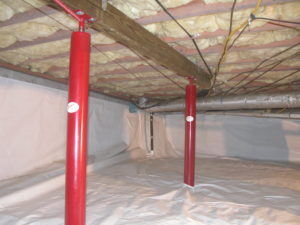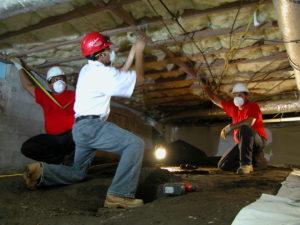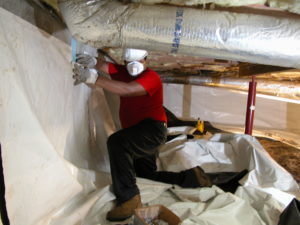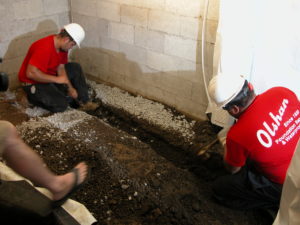
For those who want to know more about crawl space encapsulation, we’ve prepared this guide on what encapsulation is, how it’s done, and how professional installers calculate the costs of an encapsulation job.
Although we’ve given you some national (and very generalized) cost averages here, they don’t necessarily represent the prices you’ll pay locally. Chances are, if you choose your encapsulation service contractor carefully and ask them the right questions, you’ll be able to bring the job in at a price that’s much better for your individual situation and budget.’
Defining crawl space encapsulation

The goal of crawl space encapsulation is to control moisture, block pests, improve air indoor quality and prevent damage to your home. The mix and application will vary based on individual circumstances (like the condition and age of your house) but encapsulation can include these basic elements:
- Vapor barrier material designed to keep moisture out
- Dehumidifiers designed to circulate and condition the nasty air under your home
- Sealing fixtures and materials to treat vents, doors, and utility entry points
- Drainage treatments to control and remove unwanted water
- Sump pumps and dehumidifiers to prevent water encroachment and mold
- Insulation enhancements to reduce condensation and temperature extremes
All of these remedies might come into play for an extensive encapsulation job in a larger home, but for many jobs you can get it done right with a few select options. The important thing – if you suspect moisture or pest damage in your crawl space – is to get a trustworthy professional to come out and take a look. The better ones will give you a free, no-obligation evaluation and recommend the remedy mix that’s right for your home and budget.
Understanding crawl space encapsulation prices

If you do a quick check of the big national home improvement websites (think Thumbtack, Angi, or HomeAdvisor), you’ll find that they all quote similar averages.
On the high end, they report big, complex jobs running around $15,000, down to a low for small, simple jobs in the $3,600 range. Their numbers tend to average out around $6,700 for a “typical” job. The problem with broad ranges like this is that they don’t always reflect what you’ll pay locally for the specific remedies that are best for your individual case.
The important thing is not to let money fears keep you from getting an estimate and taking action on measures to protect your home. These problems usually get worse over time and can threaten your family’s health in addition to compromising your home’s structural integrity.
Experienced crawl space encapsulation companies are experts at making these jobs affordable and may be able to offer financing options. Crawl space encapsulation costs are influenced most by factors like these:
- Interior and exterior drainage enhancements. Basic French drains to clear localized moisture accumulation can run you about $0.30-$0.40 per cubic yard for drainage rock. Depending on the design, you’ll pay $0.50 to $3.00 a foot for perforated pipe.
- Vapor barrier. Standard thickness runs from 20 millimeters down to 6 millimeters. Barrier material is sold by the square foot, costing between $0.15 to $0.50 per square foot, plus another $2.00 to $4.00 per square foot for installation labor.
- Sealing materials. Vent seals cost around $10 to $20 apiece, and premade sealed access doors cost from $50 to over $100 depending on size (and excluding installation labor cost). Vapor barrier sheets are usually installed with four-inch-wide tape that costs about $50 for a 180-foot roll. Four rolls are often enough to seal a moderately sized crawl space, but cost will vary with your home’s actual square footage.
- Dehumidifiers. Depending on the amount of servicing and maintenance you want to do, an appropriately equipped dehumidifier will cost between $840 and $3200, excluding installation and service connections. Ask about capacity and upkeep. depending on the features you need and how much upkeep you’re willing to do.
- Sump pumps. A basic sump pump costs around $350 excluding the necessary installation and connection labor. More advanced units that offer multiple stages and extra features can run as high as $2500 for the unit itself, plus installation.
- Labor costs and installer fees. A reputable crawl space encapsulation expert will usually provide you with a no-cost, no-obligation evaluation that includes an itemized list of the materials and labor they propose for your restoration. It’s important to ask questions about the proposal to be certain that you’re getting good value for your investment.
- Permit fees for your jurisdiction. Not every municipality has them, but many local laws and building codes require you to pull permits for a crawl space encapsulation job. It’s important to ask the crawl space encapsulation company to call out these additional costs (which are usually calculated as a small dollar amount per $1,000 in construction value) and make sure they’re accounted for in your budget. Also make sure that everyone agrees on who is responsible for all permit documentation.
The crawl space encapsulation process

Most encapsulation jobs follow a sequence like this:
- STEP 1: Crawl space preparation and cleaning (remove debris and hazards)
- STEP 2: Improve interior and exterior drainage as needed
- STEP 3: Install vapor barrier, including specialized fasteners or tape to seal joints
- STEP 4: Seal vents, doors, and utility entry points
- STEP 5: Install and connect sump pump or dehumidifier units as needed
A combination of one or more of these five typical remedies is likely to play a part in your crawl space encapsulation (to see how Olshan does it, click here). Sometimes, small, simple jobs may only require a little prep work and a couple of interior and exterior drainage enhancements. Most will need some kind of vapor barrier treatment to ensure that your crawl space adequately protects your home from destructive pests and unwanted moisture. A reputable encapsulation expert will evaluate the condition of your crawl space and explain affordable options that are best for your situation.
Creative ways to save money on crawl space encapsulation
Before we get into some best practices for cutting costs, it’s important to note that a job like this is a critical home protection investment. Ignoring a compromised crawl space can not only lead to serious (and more expensive) structural problems, but also put your family’s health at risk with threats like mold, mildew, and disease-carrying pests. These hazards can be carried into the living areas of your home through a process known as “stack effect“. It also pays to be alert to high pressure sales tactics that may be a sign that a bidder is trying to cut corners on quality.
With those common-sense cautions out of the way, here are some proven ways to save money on your crawl space encapsulation project:
- Get multiple evaluations and ask a lot of questions before you select a crawl space encapsulation company. Check references and be sure you’re getting complete itemized price comparisons.
- Take care of the initial cleanout and preparation yourself.
- Save labor dollars by substituting self-adhesive vapor barrier material if it’s available in your area. This will not only cut installation time but reduce the need for other fastening materials.
- Don’t go for the thickest, most expensive vapor barrier. There’s a thickness that’s right for your crawl space. After that point you’re mostly paying for marketing when you upgrade to super-premium options.
- Ask your installation partner some pointed questions about the sump pump or dehumidifier they propose. A less costly model might work fine for your needs..
- Fiberglass insulation can sometimes be a cheaper option than spray foam materials. Find out of this substitution will work and provide adequate protection for your home.
Get a personalized, no-cost evaluation of your crawl space

- See all of our locations. We likely have a team of foundation repair experts near you!
- Concerned about what crawl space encapsulation for your Little Rock, AR home may cost you? Reach out to our team today! We find the most cost effective solution for whatever your home needs.


